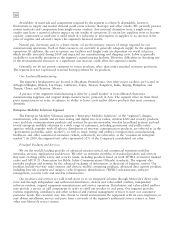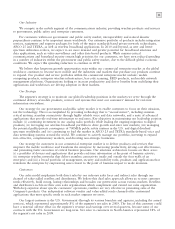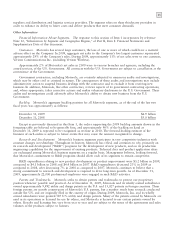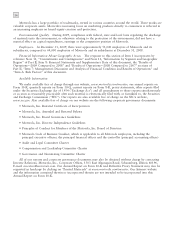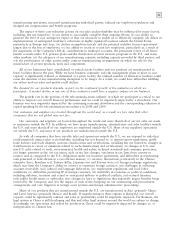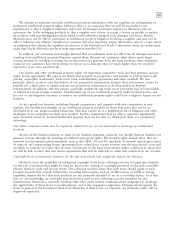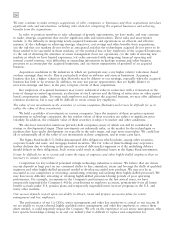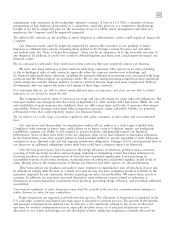Motorola 2009 Annual Report Download - page 27
Download and view the complete annual report
Please find page 27 of the 2009 Motorola annual report below. You can navigate through the pages in the report by either clicking on the pages listed below, or by using the keyword search tool below to find specific information within the annual report.
19
limits. These sales of receivables provide the Company the ability to accelerate cash flow when it is
prudent to do so. The ability to sell (or ‘‘factor’’) receivables, particularly under committed facilities, is
often subject to the credit quality of the obligor and the Company’s ability to obtain sufficient levels of
credit insurance from independent insurance companies. The volume of accounts receivable sold in 2009
was significantly lower than in prior years, driven by both lower net sales and the Company’s strategic
decision to reduce accounts receivable sales. In addition, the availability of committed facilities to sell
accounts receivable decreased due to the global financial crisis and related tightening in the credit markets.
Although the Company is not currently capacity constrained in its ability to sell receivables, it could be
limited in its ability to sell receivables in the future, particularly if the creditworthiness of our customers
declines.
•Impact on Ability to Purchase Sufficient Credit Insurance: We purchase a large amount of credit insurance
to mitigate some of our credit risks. In particular, our ability to sell receivables, particularly under
committed receivables facilities, is often subject to obtaining sufficient levels of credit insurance from
independent insurance companies. Accordingly, our ability to sell certain of our receivables, and therefore
our cash flows, could be negatively impacted if we are not able to continue to purchase credit insurance in
certain countries and in sufficient quantities. Although credit insurance remains generally available to the
Company, it has become more expensive to obtain and often requires higher deductibles than in the past.
There can be no assurances that the Company will be able to obtain sufficient quantities of credit
insurance in the necessary locations in the future.
We face a number of risks because the Company’s long-term debt rating is rated non-investment grade by one
credit rating agency resulting in the Company being a ‘‘split rated credit’’ and because our short-term debt is
rated of F-3/P-3:
Standard and Poor’s rates the Company’s long-term debt as BB+ (one level below investment grade). Fitch
Ratings and Moody’s Investor Service each rate the Company’s (i) long-term debt as BBB-/Baa3 (the lowest rating
for investment grade debt) and (ii) short-term debt as F-3/P-3. Since the Company has a non-investment grade
rating from one rating agency, it is referred to as a ‘‘split rated credit’’. As a ‘‘split rated credit’’, the Company’s
business could be impacted in a number of ways including:
•Our access to the long-term debt market is more limited: Our ability to issue long-term debt may be more
limited and the market into which split rated debt is offered can be very volatile and can be unavailable
for periods of time. Although there has been some improvement in the capital markets in the second half
of 2009, as a split rated credit, it may be more difficult for us to quickly issue long-term debt and any
debt issued is likely to be more costly. These factors may impact our operating and financial flexibility.
•Our ability to provide performance bonds, bid bonds, standby letters of credit and surety bonds could be
limited: Commercial contracts with Motorola’s customers often require performance bonds, bid bonds,
standby letters of credit and surety bonds (collectively, referred to as ‘‘Performance Bonds’’) to be issued on
behalf of the Company by banks and insurance companies. As a split rated credit, issuers of these
Performance Bonds may be less likely to provide Performance Bonds on the Company’s behalf in the
future, unless the Company provides collateral, and the costs for issuance may be higher. These limitations
on issuance may apply to the renewal and extension of existing Performance Bonds, as well as the issuance
of new Performance Bonds. Such collateral requirements could result in less liquidity for other operational
needs.
•Our ability to hedge foreign exchange risk could be limited: Counterparties may be unwilling to provide
trading and derivative lines for the Company without cash collateral. This would limit our ability to
reduce volatility in earnings and cash flow. Should cash collateral be provided, less liquidity would be
available for operational needs and financial flexibility would be reduced.
•Our ability to fund our foreign affiliates could be limited: The Company relies on uncommitted lines of
credit from banks to provide daylight overdraft, short-term loans and other sources of liquidity for foreign
affiliates. As a split rated credit, lenders may be unwilling to provide credit to our foreign affiliates. This
could result in the Company using U.S. cash to make loans to these affiliates or provide permanent equity
where loans are not possible. If this occurs, less liquidity would be available for other operational needs
and financial flexibility would be reduced.
•Trade terms with suppliers could become less favorable: Given the Company’s split rating, suppliers may
require letters of credit, cash collateral or other forms of security as part of standard payment conditions.
Such requests could result in reduced liquidity and less leverage in pricing negotiations.



